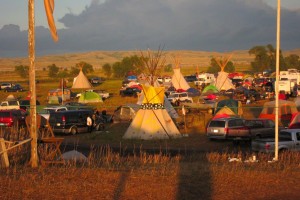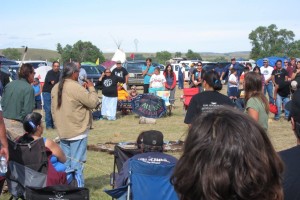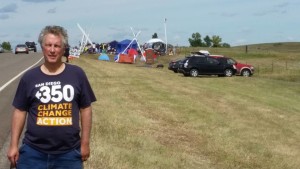Originally published in the San Diego Free Press, October 27th, 2016
By Chris Barroso
As a member of San Diego’s 350.org, I’d followed the story of the Dakota Access Pipeline (DAPL) for some time, telepathically urging the protesters on. And then one day, my friend Paul Sasso called me. “Hey, let’s go up and join the protesters. We’ll take my Tesla.” Yeah, I replied. I could do that; the next week wasn’t too busy, or the week after that. When are you thinking? I asked. “I’ll pick you up in a couple hours,” he said. Whoa, I thought for a moment; but I hurriedly packed, and soon we were off to the North Country.
On the way we talked about this 30 inch diameter pipeline, the rivers (Big Sioux, Missouri, and Mississippi) and the tribal lands it would cross. Eminent Domain, one of us said, shaking our head. Did it translate in Native American languages to “broken treaty”?
Another topic of discussion: major spills are common for oil and gas pipelines—a question of when, not if. As Bill McKibben explained in a New Yorker editorial, the pipeline was originally supposed to cross the Missouri River near Bismarck but those plans changed over concerns that an oil spill at that location would have wrecked the state capital’s drinking water. So the pipeline was shifted to a crossing half a mile from the Standing Rock Sioux tribe’s treaty lands. Nice. Just how angry were these protesters going to be? It seemed only reasonable that some of that anger might flare in my light-complexioned direction. I took a deep breath as I watched the prairie fly by.

We arrived on September 9th, the Friday after Labor Day, and rolled into the main camp, called Oceti Sakowin, (Och-et-ee shak-oh-win), meaning Seven Council Fires. As we strolled around the camp and met all kinds of people from all over the country, and all happy to chat, the little knots of anxiety in my stomach uncoiled. A fellow there from Florida with his family not only lent us a tarp but helped Paul and I set it up with the tent we borrowed. Everyone was warm, friendly, and thanked us for our visit. They want as many people as possible to come and help carry the message of protecting the water; not just for those of us alive now but for our children and grandchildren too. That’s why they called themselves protectors, not protesters. Fitting, I thought. Accurate.
The benevolent sense of community was almost intoxicating, buoyed on a solid feeling of safety. In keeping with their peaceful intent, no weapons, drugs, or alcohol were permitted in the camp. In addition, no one was allowed to go to the front lines of the protection efforts unless they’d gone through non-violent protest training, how to be arrested peacefully, and so forth. Where I’d expected a seething cauldron of outrage and anger, I found none. Instead I found a pervasive cheerfulness, an industrious camp filled with thousands of souls, humming along smoothly.

Paul and I helped out where we could. We chopped wood for a few hours and then I spent a couple more washing dishes. Some people have established positions but nobody is boss; the title “head chef”, for example, belongs to several. With all those bellies to feed the kitchen is constantly busy, early morning until midnight. To help out, you look for someone who seems tired and offer to take over for a while. Another place to pitch in is handling deliveries that constantly pulled up: fire wood (the camp runs on it), food, donated clothing, etc.
The flags of at least 182 Native American nations lined the road into the camp and more rose during the two days we were there. Those days were warm but the nights were quite chilly. I shivered the first morning from the cold and also from thinking what lay ahead for these brave people who intended to see it through to the end, to make their stand through whatever comes.

And it was what had already come, just five days before, that kicked me in the gut and haunts me still.
Another protectors’ camp, we learned, sits about two miles north of ours. A lawsuit had been filed demanding a halt to planned construction at that location, as ancient and sacred Native American artifacts had been discovered there. Under Federal law, when artifacts are discovered construction must immediately stop. But over the Labor Day weekend, before the court could respond, Energy Transfer Partners (DAPL owners) jumped. They moved bulldozers twenty miles ahead of their current construction zone and razed the land, destroying the ancient artifacts. Federal law also requires that any permit be denied after such actions, yet the company received no punishment for their crimes and pipeline construction is continuing to this day.

With heavy hearts, Paul and I hitchhiked to the site. The bulldozers’ muddy scars cut deep into my soul. We’ll take pictures of this desecration, we said, let the world see what happened. Please don’t, the protectors asked us. Sacred means sacred, even if it is defiled beyond recognition.
Bury my heart. Run over it with hobnobbed boots, stomp it into the soil. It is not my heart that suffers, though one will. Our drive home was somber.
But the protests continue, and public consciousness has been raised to the injustice, greed and non-sense of the fossil fuel industry. With abundant renewable energy like solar and wind now commonly more economical than oil, we know these are just the dying gasps of a buggy-whip industry.heart. Run over it with hobnobbed boots, stomp it into the soil. It is not my heart that suffers, though one will. Our drive home was somber.
But the protests continue, and public consciousness has been raised to the injustice, greed and non-sense of the fossil fuel industry. With abundant renewable energy like solar and wind now commonly more economical than oil, we know these are just the dying gasps of a buggy-whip industry.
Chris Barroso is a wireless communications electrical engineer who’s lived in Encinitas for the past eleven years. He’s long been active in the peoples’ politics: Move On, Occupy, 350.org, a Bernie Sanders delegate to the Democratic Convention, and lately, Applegate for the 49th US Congressional district.
No DAPL and No TPP!
